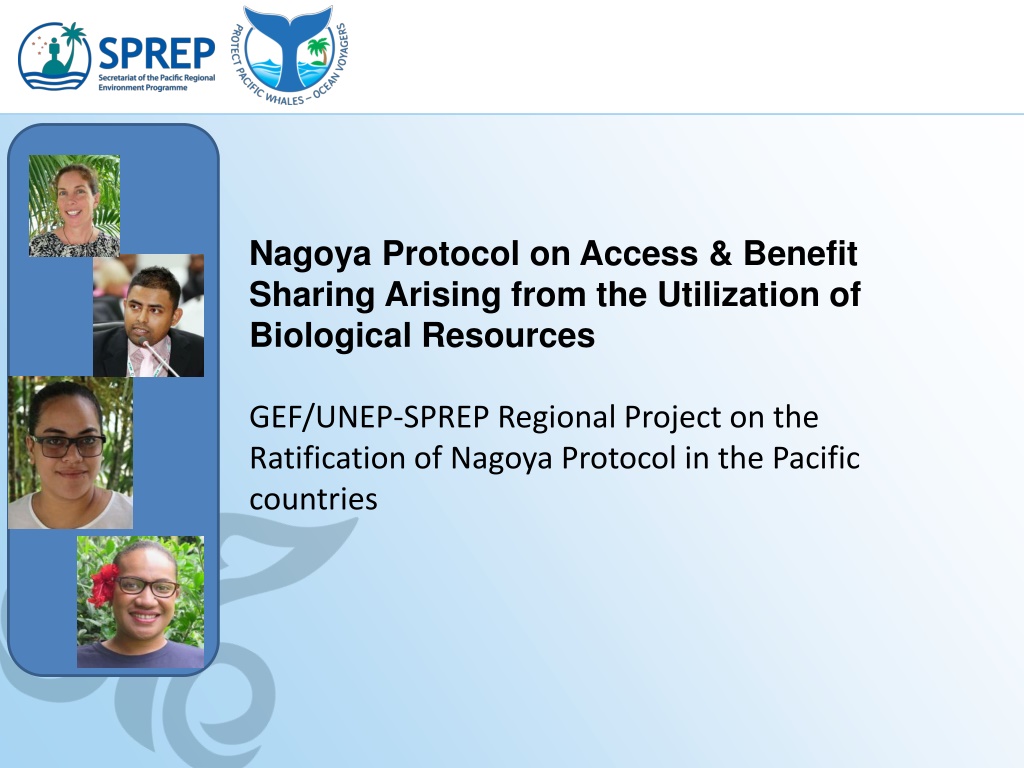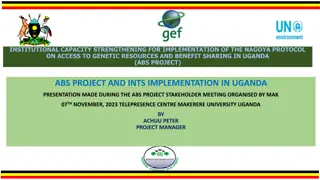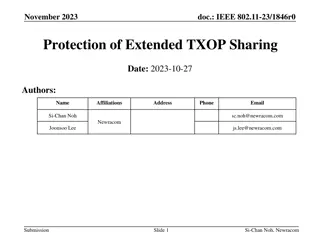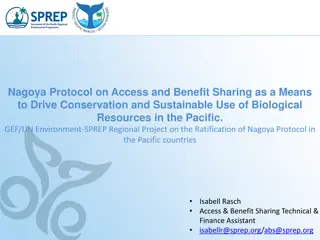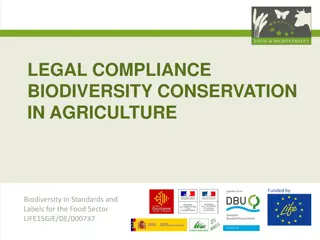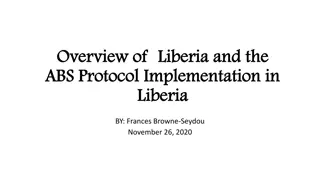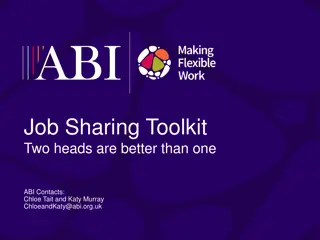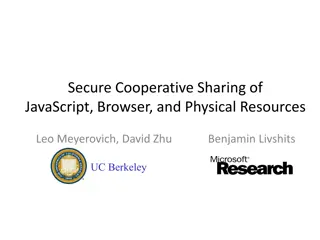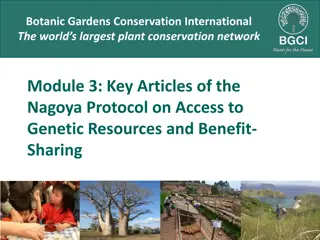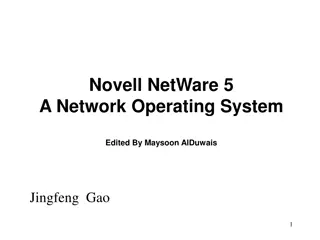Understanding the Nagoya Protocol on Access and Benefit Sharing
The Nagoya Protocol, a supplementary agreement to the Convention on Biological Diversity, aims to ensure fair and equitable sharing of benefits from genetic resources. It provides a legal framework for accessing and utilizing biological resources, emphasizing transparency and sustainability. The Protocol promotes conservation efforts, supports indigenous knowledge, and fosters economic development while safeguarding biodiversity. Its implementation creates incentives for responsible resource management and contributes to global well-being.
Download Presentation

Please find below an Image/Link to download the presentation.
The content on the website is provided AS IS for your information and personal use only. It may not be sold, licensed, or shared on other websites without obtaining consent from the author. Download presentation by click this link. If you encounter any issues during the download, it is possible that the publisher has removed the file from their server.
E N D
Presentation Transcript
Nagoya Protocol on Access & Benefit Sharing Arising from the Utilization of Biological Resources GEF/UNEP-SPREP Regional Project on the Ratification of Nagoya Protocol in the Pacific countries
Introduction Background context Relevance Scope & Linkages to Sustainability & Conservation Key Concerns Conceptual Framework Way forward & GEF-UNEP-SPREP Regional Project on the Ratification of the Nagoya Protocol in the Pacific
The Nagoya Protocol on ABS is a supplementary agreement to the Convention on Biological Diversity (CBD), adopted on 29 October 2010 and entered into force on October 12, 2014. Almost 4 years after it was agreed The objective- Provide a transparent legal framework for the effective implementation of one of the 3 objectives of the CBD- The fair and equitable sharing of benefits arising from the utilization of genetic resources. Why Nagoya? It ensures the/that; biodiversity-rich countries obtain a fair share of benefits arising out of the use of their genetic resources by setting out a clear and transparent framework for ABS benefit-sharing, through technology transfer, research results, training and profits, can contribute to poverty reduction and sustainable development (Monetary and non- monetary benefits) development contributing to human well-being through the use of genetic resources in pharmaceuticals, cosmetics, agriculture and many other sectors ABS is essential to better understand nature through taxonomic research
Relevance of Nagoya Protocol NP is intended to create greater legal certainty for both providers and users of genetic resources through a) Establishing more predictable conditions for access to genetic resources b) Ensure benefit sharing when genetic resources leaves the contracting party providing the genetic resources Why are genetic resources important in conservation & sustainability? They provide crucial information to better understand nature They can be used to develop a wide range of products and services for human benefit The way in which genetic resources are accessed and how the benefits arising from their use is shared can create incentives for: The conservation and sustainable use of biodiversity. The creation of a fairer and more equitable economy to support sustainable development
Scope of the Nagoya Protocol and Linkages to Traditional Knowledge(TK) Nagoya Protocol applies to genetic resources and the benefits arising from their utilization. It also covers TK associated with genetic resources and the benefits arising from their utilization. In ABS, TK refers to the knowledge, innovations and practices of indigenous and local communities related to genetic resources Why For centuries, indigenous and local communities (ILCs) have learned, used and passed on knowledge about local biodiversity and how it can be used for a range of purposes is traditional knowledge important? Indigenous and local communities rely on genetic resources and have helped preserve, maintain and increase biodiversity over centuries Traditional knowledge related to biological resources can be an important source of information for identifying new uses of genetic resources The leads provided by traditional knowledge in identifying the properties of genetic resources have enabled industries to develop new products and have helped scientists understand biodiversity
Key Issues under the ABS Framework HOW DOES ABS WORK? WHAT IS PRIOR INFORMED CONSENT? The permission given by the competent national authority of a provider country to a user prior to accessing genetic resources, in line with an appropriate national legal and institutional framework It is based on: Prior informed consent (PIC) being granted by a provider to a user Negotiations between the provider and the user to develop mutually agreed terms (MAT) that ensure that the benefits from the use of genetic resources are shared equitably WHAT ARE MUTUALLY AGREED TERMS? An agreement reached between the providers of genetic resources and users on the conditions of access and use and the benefits to be shared between both parties
Key Concerns People access biological resources with out approval or consent of providers ( This is stealing, unethical, unacceptable ) The results of bioprospecting can lead to billion dollar industry (cosmetics, pharmaceutical, innovations etc.) but seldom the benefits of such discovery is shared fairly & equitably with the providers All research regardless of its results lead to knowledge generation and thus people who provide access to their resources for such research need to benefit / acknowledged for their contribution Issue of sovereignty of states over their biological resources Protection of traditional knowledge and practices
Stakeholders of ABS PROVIDERS OF GENETIC RESOURCES: States have sovereign rights over their natural resources Laws within the provider country determine rights over genetic resources at the national level, who has the authority to grant access to genetic resources and who should be involved in the negotiation of mutually agreed terms with potential users (e.g. private land owners, indigenous and local communities) USERS OF GENETIC RESOURCES: A diverse group, including botanical gardens, industry researchers such as pharmaceutical, agriculture and cosmetic industries, collectors and research institutes National Focal Points (NFPs): Responsible for providing information on ABS, such as the requirements for gaining access to genetic resources Competent National Authorities (CNAs): Established bygovernments and responsible for granting access to their genetic resources Represent providers on a local or national level They seek access for a wide range of purposes, from basic research to the development of new products Users seek access to genetic resources for: Scientific research (e.g. taxonomy) Development of commercial products (e.g. pharmaceuticals) Providers of genetic resources grant access: In exchange for a share of the benefits that result from their use
Obligations The Nagoya Protocol sets out obligations for contracting parties to take measures in relation to access, benefit sharing and compliance Users seeking access to genetic resources must: Get permission from the provider country (known as prior informed consent or PIC) Both provider and user must: Negotiate an agreement to share resulting benefits (known as mutually agreed terms or MAT) Benefits arising from the use of genetic resources may be: Monetary when research and developments leads to a commercial product (e.g. royalties, milestone payments, licensing fees) Non-monetary (e.g. technology transfer, enhancement of research skills)
Way forward & GEF-UNEP-SPREP Regional Project on the Ratification of the Nagoya Protocol in the Pacific Objective: To support Pacific Island countries to ratify the Nagoya Protocol & to implement key measures to make the Protocol operational. Components Prepare baseline analysis for the identifying of common assets, issues & needs Assist countries to ratify the NP through supporting national authorities. Establish enabling environments for the implementation of basic provisions of the NP. Address regional coordination and technical support.
